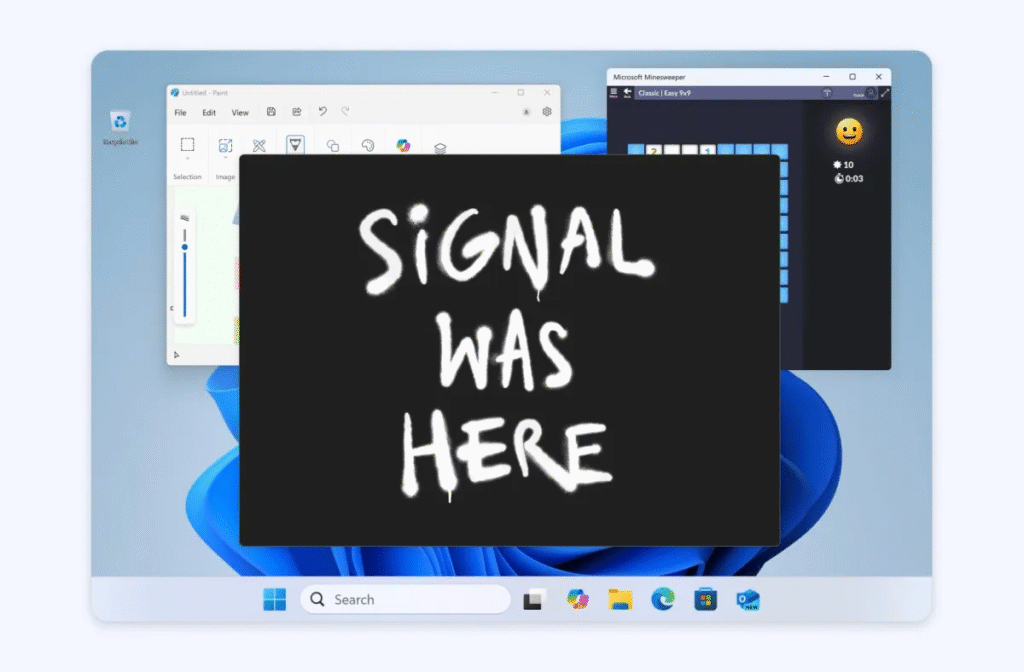Signal has rolled out a critical privacy-focused update for its Windows app, introducing a “screen security” setting that prevents the system from capturing screenshots—directly countering Microsoft’s controversial Recall feature.
This move reinforces Signal’s commitment to user privacy, ensuring sensitive conversations remain protected even against AI-powered background surveillance. Here’s everything you need to know.
Why Signal Is Blocking Windows Screenshots
Microsoft Recall: A Privacy Concern
Microsoft’s Recall feature (announced in 2023) continuously captures and stores screenshots of user activity, allowing Windows 11 users to “scroll back in time” and revisit past actions.
Despite Microsoft pausing Recall’s rollout after backlash, the company reintroduced it in April 2024 via the Windows Insider Preview Channel with key changes:
✔ Opt-in requirement (users must enable it manually)
✔ Pause functionality (temporary deactivation)
However, Signal argues that Recall still poses risks:
🔴 Potential exposure of sensitive chats (even if encrypted)
🔴 Lack of granular app-level control (Recall captures everything by default)
How Signal’s “Screen Security” Works
When enabled, this setting:
✅ Blocks Windows from screenshotting Signal’s window (shows a blank screen instead)
✅ Prevents Recall from storing private conversations
✅ Maintains end-to-end encryption integrity
⚠ Trade-off: Some accessibility tools (like screen readers) may not function properly with this setting active.
How to Enable (or Disable) Signal’s Screen Security
Step-by-Step Guide
- Open Signal Desktop
- Go to Settings > Privacy > Screen Security
- Toggle “Block screenshots” (enabled by default)
🔹 Disabling the feature requires confirmation (to prevent accidental deactivation).
🔹 A warning appears reminding users of potential privacy risks.
Signal’s Critique of Microsoft’s Approach
In a blog post, Signal expressed frustration with the need for such workarounds:
“We hope that AI teams building systems like Recall will consider these implications more carefully. Apps like Signal shouldn’t need a ‘one weird trick’ to protect user privacy—developers deserve better tools.”
Key Issues with Recall
🔸 No API for apps to opt out (forcing manual workarounds like Signal’s)
🔸 Potential security vulnerabilities (stored screenshots could be accessed by malware)
🔸 Privacy vs. convenience imbalance (users may not fully understand the risks)
What This Means for Windows Users

✔ Signal users gain stronger privacy protection against Recall.
✔ Other encrypted apps (like WhatsApp, Telegram) may follow suit.
✔ Microsoft faces continued scrutiny over AI-powered surveillance features.
Should You Disable Recall Entirely?
If privacy is a priority:
- Avoid enabling Recall (if using Windows Insider builds).
- Use Signal’s screen security for encrypted chats.
- Monitor future Windows updates for improved privacy controls.
Final Verdict: A Necessary Move for Privacy
Signal’s update highlights the growing tension between AI convenience and user privacy. While Microsoft positions Recall as a productivity tool, its always-on screenshotting raises legitimate security concerns.
By proactively blocking Recall, Signal sets a precedent—tech companies must prioritize privacy by design, not as an afterthought.








